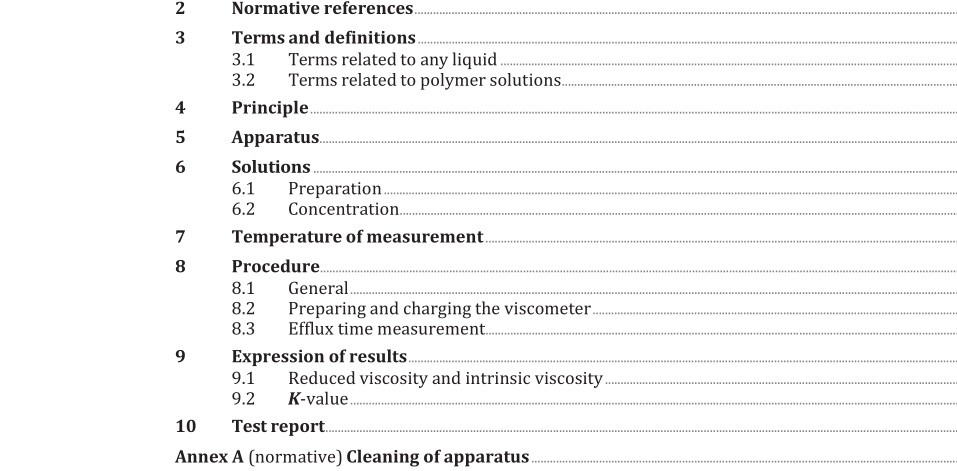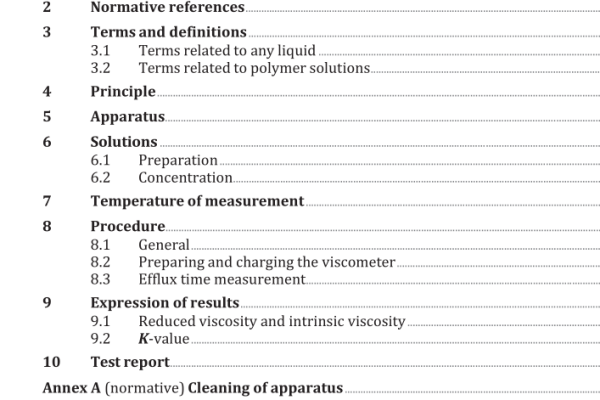ISO 1628-1:2021 pdf download – Plastics — Determination of the viscosity of polymers in dilute solution using capillary viscometers — Part 1: General principles.
6.2 Concentration Where no standard exists, careful consideration shall be given to the choice of solvent and the solution concentration. The solution concentration shall be chosen so that the ratio of the efflux time of the solution to the efflux time of the solvent is at least 1,2 and less than 2,0. NOTE A lower limit of 1,2 ensures sufficient precision of the measured difference in efflux times. The upper limit of 2,0 prevents shear effects and non-linearity of the viscosity number in relation to concentration that can occur at higher molecular masses. More than one concentration can therefore be used for a given polymer/solvent system, depending on the molecular mass of the polymer under test. The concentration is preferably expressed in kg/m of solution or as the multiple 10 kg/m , i.e. g/cm . 7 Temperature of measurement The temperature shall be chosen with due regard to sufficient solubility and other technical requirements, but kept constant for any particular polymer/solvent system. The temperature tolerance shall be specified. A temperature of 25 °C ± 0,05 °C shall be chosen whenever possible. If another temperature is used, use the temperature that was agreed between the parties concerned and stated in the test report. 8 Procedure 8.1 General Measure the efflux times for the solution and the solvent successively in the same viscometer, using the procedure described in 8.2 and 8.3. 8.2 Preparing and charging the viscometer 8.2.1 Maintain the bath at the specified test temperature. 8.2.2 Charge the dry, clean viscometer (the cleaning procedure is specified in Annex A ) by tilting it about 30° from the vertical and pouring sufficient liquid through tube L (see Figure 1 or Figure 2) so that, when the viscometer is returned to the vertical, the meniscus is between the filling marks G and H. Avoid trapping air bubbles in the viscometer. The initial filling may be carried out away from the bath. 8.2.3 Mount the viscometer in a holder in the bath, ensuring that tube N is vertical. Allow time for the charged viscometer to reach the temperature of the bath. Usually, 15 min will suffice if the measurement is to be made at 25 °C. At higher temperatures, longer times is necessary. Unnecessary delays should be avoided as it is found that the most consistent results are obtained shortly after temperature equilibrium is attained with a freshly charged viscometer. 8.2.4 This procedure shall also be followed when a measured amount of solvent is added to a solution, already contained in the viscometer, in order to create a more dilute solution for additional determinations. The additional solvent shall be maintained at the specified test temperature prior to use. 8.2.5 In automated equipment, the viscometer is fixed in the vertical position within a temperature- controlled bath and the apparatus is designed to fill the viscometer with liquid in this position. The bath shall be maintained at the specified test temperature and an equilibration time selected in accordance with 8.2.3.
ISO 1628-1:2021 pdf download – Plastics — Determination of the viscosity of polymers in dilute solution using capillary viscometers — Part 1: General principles






